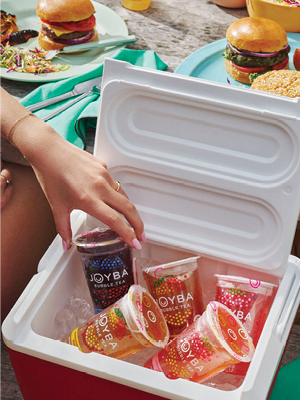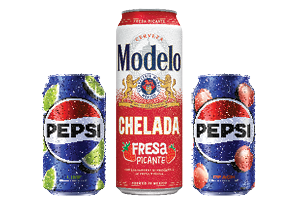The idea that a drink is an experience isn’t new: Ask anyone who has waited for a well-poured Guiness, or gone out of their way to a store that sells “chewy” nugget ice with its fountain sodas. But the experiential factor of drinks that conjure sensory reactions from flavors, textures or memories is becoming more important, and is penetrating all the way to packaged beverages.
The arrival of bubble tea, or boba tea, at Sheetz stores earlier this year signaled that convenience stores are fully aboard the beverage experience train. Bubble tea’s unique taste profile comes from the boba pearls featured in the drinks, providing consumers with a beverage that actually involves chewing, followed by a burst of flavor when they bite into the tapioca balls.
The Pennsylvania-based Sheetz’s offer—boba mango popping bubbles added to a Sheetz Refresherz drink for an $1.79 upcharge—could set the stage for an entirely new category in the channel.

“Bubble tea could work in convenience stores because one of the areas where c-stores do really well is in dispensed beverages and the condiment bar,” said Claire Conaghan, associate director and trendologist at Datassential.
Conaghan noted that the drinks are becoming more commonplace, pointing to success at QSR chains like Del Taco and Dunkin’, not to mention Starbucks’ recent introduction of bubble tea on its summer menu. Joyba, the packaged bubble tea from DelMonte foods, recently announced that it is now available in stores across the country, including Circle K.
Moreover, consumers—particularly younger and Gen Z consumers—are increasingly embracing drinks that feature interesting ingredients, an immersive experience and connote socialization, typically enhancing retail margins. “These consumers love to customize their beverages,” Conaghan said.
These consumers love to customize their beverages.”
Targeting the Senses
Major packaged beverage marketers are also helping to build beverage experiences for consumers with a wave of new and limited time only (LTO) drinks that keenly target one or more sense. They go beyond simply incorporating a flavor—they elevate the experience by creating a mouth sensation, like those felt when you eat spicy food or the numbing effects from mint or cooling agents, for example.
Spicy and “swicy” (sweet and spicy combination) drinks have been quick to emerge on the heels of the spice craze in other product categories, such as salty snacks.
According to Datassential’s Menu Trends platform, which tracks trends at some 4,800 restaurants around the country, several spicy or spice terms are showing fast growth, including tajin (+286%), jalapeno (+97%), and turmeric ginger (+80%). “There’s a certain demographic that loves heat, as well as pairing it with honey, which adds a flavor intrigue,” Conaghan explained. “This trend will keep going.”

Coca-Cola famously launched Coca-Cola Spiced and Coca-Cola Spiced Zero Sugar earlier this year as a permanent addition to its line. According to the soft drinks giant, the new products blend the traditional Coke with raspberry and warm spiced flavors. The brand said it’s “not spicy,” in the traditional sense, but has a warm, bold and robust flavor that rounds out the original taste of coke. Dr Pepper also fronted a spicy version last year, Dr Pepper Hot Take, albeit on a very limited basis. Keurig Dr Pepper said the drink “harnesses the bold flavors of spicy peppers,” and was available exclusively to the brand’s Pepper Perks loyalty members.
Among other players, Starbucks capitalized on the swicy trend with the launch of its Spicy Lemonade Refresher LTOs last spring. The three fruity flavors of refreshers—pineapple, dragon fruit and strawberry—are spiced with the chain’s proprietary chili powder blend, creating sweet tropical fruit sips that are followed by a contrasting spicy kick.
Social media platforms like Instagram, Snapchat and TikTok depicting colorful drinks are helping to grow awareness."
But at least one convenience retailer is skeptical of the spice play in packaged beverages. “While hot and spicy [snacks] have been very successful in the center store, with beverages it’s more of a challenge,” said Nathan Arnold, director of marketing at Englefield Oil Inc., operator of Duchess c-stores in Ohio and West Virginia. “Most consumers don’t like to think of drinks that are made to be refreshing as hot and spicy.”
Balancing out the heat options, Coca-Cola launched the Sprite Chill LTO earlier this year, which it said features a “proprietary blend of cooling agents to deliver a uniquely elevated sensory experience” by chilling the drinker’s mouth and creating a numbing sensation. Through a balance of cherry-lime flavor and cooling intensity, “Sprite Chill is one of the first sparkling soft drinks to deliver a cooling sensation without an accompanying mint flavor,” the company said when announcing the launch.
And thanks to caffeine, energy drinks, of course, have long strived to provide consumers with a jolt. At Duchess convenience stores, the big trend today within energy drinks—which are growing at a double-digit rate—is even higher caffeine, Arnold said, “providing an ultra-energy jolt.” PepsiCo’s Rockstar Focus label, rolled out earlier this year, contains 200 mg. of caffeine per serving “to provide a blend of energy and mental clarity,” said Bryan Santee, chief commercial officer at PepsiCo Beverages North America.
Evoking Feelings Through Flavors
PepsiCo, meanwhile, has been highlighting food-and-beverage-pairings in recent years, drawing on classic combos or quintessential events, like a summer barbeque, to evoke memories or feelings that enhance the experience of its drinks. The “Better with Pepsi” initiative was introduced in 2021 “because we believe pairing with particular foods, including burgers, pizza, hot dogs and barbeque, represents unique consumption moments that are better with one of our Pepsi products in hand,” Santee said.
This summer, Pepsi collaborated with chef Bobby Flay on two LTOs designed to “punch up the quintessential American BBQ,” according to Santee—Pepsi Lime and Pepsi Peach. “The tangy citrus bite of lime and the plush sweetness of a ripe peach are popular nostalgic summertime flavor profiles, and when combined with the crisp and refreshing taste of Pepsi, provide a delectable sweet and refreshing flavor that enhances the bold, dynamic, and smokey savory flavors created on a grill,” PepsiCo said in announcing the LTOs.
Visual Appeal
Beyond taste, trendy beverages like bubble tea are providing consumers with aesthetic touchpoints. Colors and other visual cues bode well for drinks such as bubble tea and dirty soda. Like bubble tea, dirty soda—generally a sparkling beverage topped off with a creamy drink—shows potential in convenience stores.
“It makes perfect sense for c-stores,” Conaghan said, “as they already stock sodas, energy drinks and creamers.” Social media platforms like Instagram, Snapchat and TikTok depicting the colorful drinks are helping to grow awareness. With bubble tea, for example, consumers can sometimes select the shade of pearls they’d like to complement or contrast with the drink. The addition of creamer to a soda, meanwhile, “creates a pretty swirling image that’s fun to share,” Conaghan said.
[Dirty soda] makes perfect sense for c-stores as they already stock sodas, energy drinks and creamers.”
Cultural Contributors
Cultural influences are also playing a role in today’s beverage experiences. Indeed, much of the food and beverage spice trend is rooted in Latin culture. According to Datassential’s Menu Trends, mangonadas have soared more than 400% on non-alcoholic beverage menus at restaurants over the past year. A combination of mango sorbet, chopped fresh mango or mango purée, mangonadas are typically accented with the salty, spicy and tangy flavors of tajin and chamoy. In the alcoholic beverage space, micheladas—a drink made with beer, lime juice, tomato juice and assorted spicy sauces—and particularly Modelo Chelada, are gaining ground. Modelo Chelada’s latest flavor, Fresa Picante, is made with the Mexican beer, sweet strawberry flavors and chili peppers.
Before a beverage brand makes its way to c-stores, marketers must first ensure there’s a market for it. PepsiCo’s Santee said that the brand’s research and development department is committed “to being at the forefront of science and technology to create novel beverage experiences that leverage the latest flavors, trends, and cultural influences. [Our] experts are consistently exploring and tracking how our consumers’ everyday experiences are changing, and what this means for their beverage consumption, so that we can deliver on their individual preferences.”
Santee advises that when new brands do hit the market, convenience retailers devote special attention to them. “Creating innovation destinations can introduce new experiences to shoppers by ensuring these products and brands have the right in-store racks and positionings and the right campaign and assets at point of sale,” the PepsiCo executive explained. That’s something you’ll find at Duchess stores, where “innovation shelves” highlight new brands and test their potential for permanent placement. Among the products on the innovation shelf recently, according to Arnold, was a Liquid Death iced tea.
As with any new products, promotions are critical to drive trial and awareness of new beverages and aid customers in their beverage journeys. Santee suggests that c-stores cross-merchandise the beverages with menu items to encourage shoppers to sample the new products. Tactical merchandising practices around new drinks can go a long way in building c-store baskets while elevating consumers’ beverage experience.